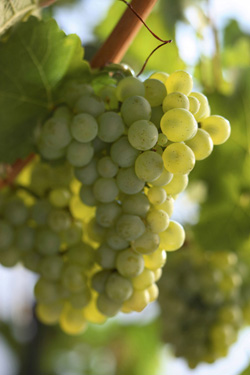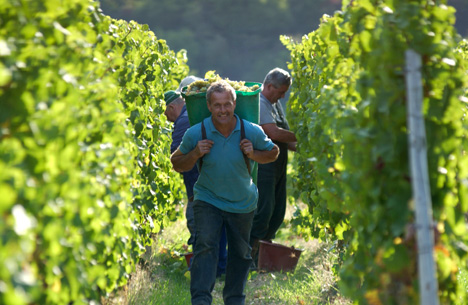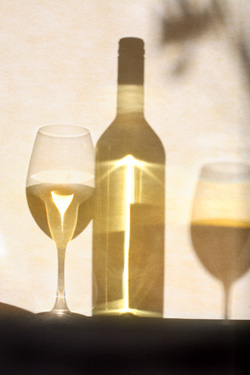In just a few years, Sauvignon Blanc has become a real fashionable variety in Germany. In the meantime, well over 500 hectares of Sauvignon are cultivated by more than 500 producers. For purists, however, the variety is often a nuisance, a foreign body in the German varietal spectrum. They are not aware of the tradition in which it stands. The once popular grape variety was only banned from German vineyards by the Nazis because it was considered un-German and an "enemy variety". Sauvignon - mostly under the name Muskatsylvaner - has been cultivated in Germany for at least 300 years. Especially in Baden and also in Franconia, Sauvignon was highly valued, and at least one theory says that the grape, which is closely related to Traminer and Chenin Blanc, first came from Great Moravia to Franconia and from there to France.
 |
| Sauvignon Blanc is one of the so-called "Cépages nobles"% the noble grape varieties of the world. (Photo: DWI) |
Even though Sauvignon has a relatively well-defined aroma profile (ranging from grass to herbs, green berries, pome fruits as well as peppers and sometimes other green vegetables to elderflowers and berries), its wines differ considerably depending on their origin and winemaker's philosophy, and there is sometimes disagreement, if not even dispute, among wine lovers as to what the "true" Sauvignon should taste like.
At the lower end of the maturity scale is the extremely green, grassy and acidic, aromatically often rather loud version. It is extremely popular with some Sauvignon enthusiasts, presumably because these wines can hardly be confused and their striking aroma jumps out at the wine drinker from the glass. But you can twist and turn it however you like: you have wine from unripe grapes in the glass that hardly does justice to the qualities of the variety.
Ripe, healthy grapes harvested not too late and especially in cooler locations produce an extremely stimulating, lively, sometimes even racy wine, whose aromas are still predominantly green, but no longer seem unripe and loud, but rather fine, herbaceous-grassy and elegant-fruity. The loud aromas of the unripe version give way to subtle floral aromas reminiscent of elderflower and the also quite characteristic notes of elderberry. Even quite strong examples can still be cool and animating due to their special aromatics and vital acidity. The classic role model of this style are the rather more restrained wines from the Loire, but for quite a while now, the usually somewhat more open-hearted and exotic-looking Sauvignons from New Zealand have been competing with this ideal image. All over the world, the wines tend more in one direction or the other, depending on the location and the imagination of the respective producers. Many European wine regions are much closer to the Loire model, even if many of them, such as South Tyrol or Styria, not to mention the Bordelais, have long since developed their own regional character. Germany is still in its infancy in this respect.
 |
| The time of harvest determines the character and aromatic expression of the wine. (Photo: DWI) |
Particularly in Styria and California, but also in other wine-growing regions, exceptionally rich dry Sauvignon is produced from extremely ripe grapes. The aroma is reminiscent of very ripe pears and other, sometimes exotic yellow fruits, ripe avocado and sometimes sugar snap peas. Since wines of this weight class are usually matured in small wooden barrels, candy notes, roasted aromas and nutty and buttery tones are added. The best examples of this style can age for decades. In recent years, however, the public's taste has clearly moved in the direction of leaner and more elegant wines, and so the number of overly opulent wines with conspicuous wood notes is now decreasing significantly almost everywhere.
We do not want to forget the noble sweet variety. Especially in the Bordelais, and there mostly in combination with Sémillon, majestic and incredibly long-lived dessert wines are produced with Sauternes and Barsac in top form, which with their opulence, their power and the omnipresent wood spice were and are the model for many sweet wines of the world. They represent the counter-design to the generally much leaner German noble sweet high quality wines, which are indispensable as dessert accompaniments.
 |
| In Germany, too, Sauvignon shows its diversity - from animating summer wines to opulent food companions. (Photo: DWI) |
As already noted, German producers are generally still a long way from developing a clear style that ideally also expresses the origin of the respective wines. From unripe and grassy to lush and woody, you can find every variation almost everywhere. In the worst case, the wines seem uninspired, and it is not uncommon to think that the Sauvignon simply has to be made just as lime-sweet as other varieties. But what may fit with Traminer or Scheurebe, and perhaps just about works with Riesling, usually goes completely wrong with Sauvignon. In such cases, one seriously wonders why the Sauvignon was needed in the assortment in the first place.
However, we are surprised again and again at how well the wines of many producers consistently succeed - and that across the different varieties. Apparently, special effort is made with the youngest child in the portfolio. There is hardly any other explanation for the fact that Sauvignon sometimes outshines Riesling and Burgundy in many a range. The pride of the producers in these children is, however, quite often reflected in the prices, which are sometimes noticeably higher than those of roughly equivalent wines from other varieties.
There is no doubt, however, that Sauvignon is an enrichment for the grape variety portfolio in Germany, even if many a conservative wine lover may still grumble about the prodigal son who has now returned home. With its idiosyncratic aroma spectrum, it fills a gap that Scheurebe, with which Sauvignon is often compared, was unable to fill. Even today, Sauvignon is therefore an exciting topic that can only get more interesting as the years go by.
To the "BEST OF Sauvignon Blanc Germany" (PDF document)
All currently tasted German Sauvignon Blancs in the wine guide